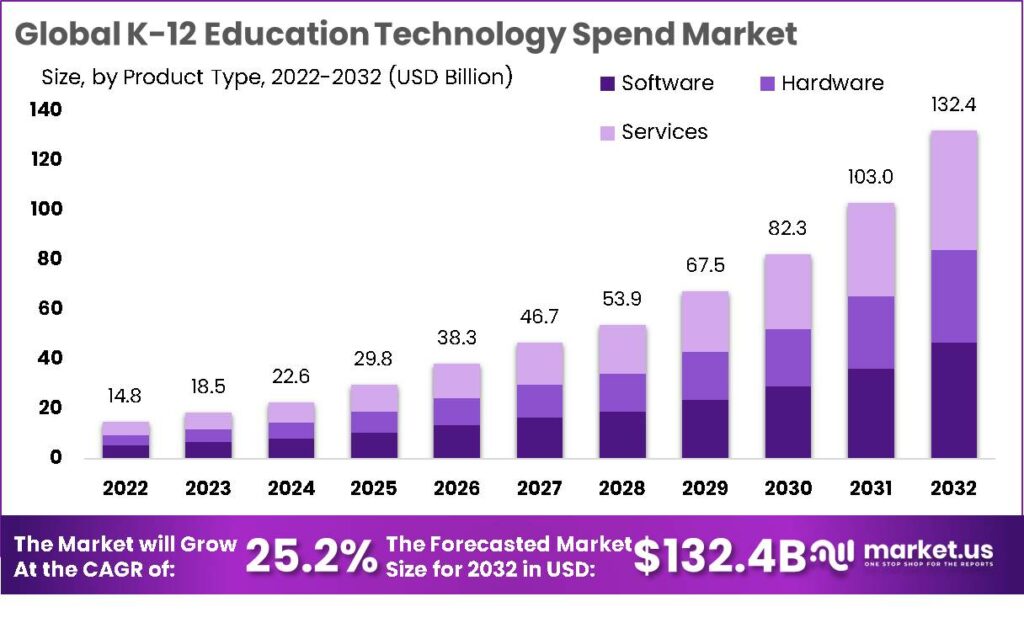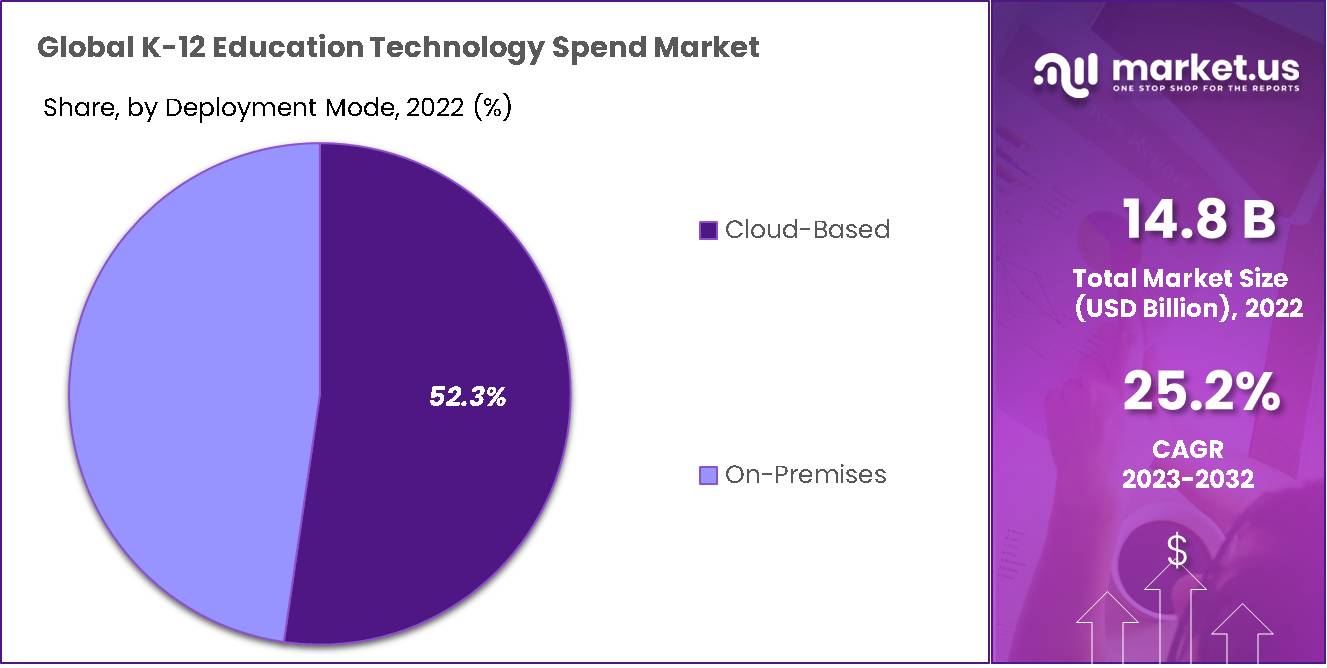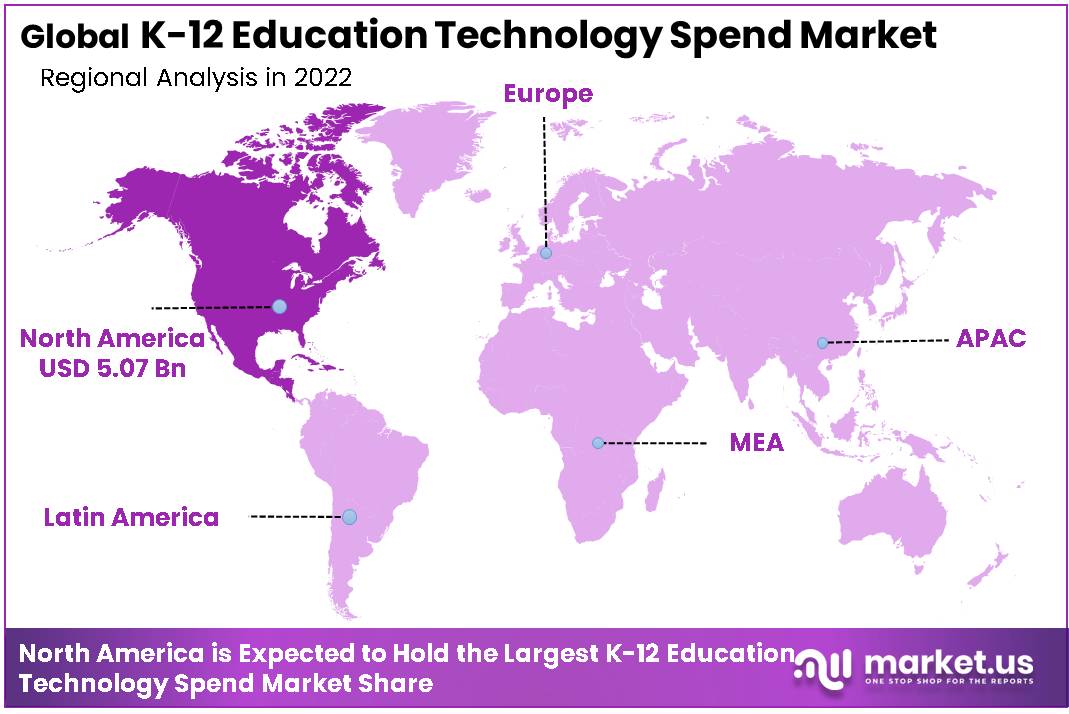Global K-12 Education Technology Spend Market By Product Type (Hardware, Software, and Services), By Deployment Mode (On-Premises and Cloud-Based), By Application (Pre-primary School, Primary School, Middle School and High School), By Region and Companies – Industry Segment Outlook, Market Assessment, Competition Scenario, Trends, and Forecast 2023-2032n and Companies - Industry Segment Outlook, Market Assessment, Competition Scenario, Trends, and Forecast 2023-2032
- Published date: March 2024
- Report ID: 107024
- Number of Pages: 388
- Format:
- keyboard_arrow_up
Quick Navigation
Report Overview
The K-12 Education Technology Spend Market size is expected to be worth around USD 132.4 Bn by 2032 from USD 18.5 Bn in 2023, growing at a CAGR of 25.2% during the forecast period from 2023 to 2032.
K-12 education technology spend refers to the expenditure on technology products, services, and solutions specifically designed for the K-12 education sector. This includes hardware devices, software applications, learning management systems, online educational resources, and other digital tools that enhance teaching and learning experiences in schools.
The K-12 education technology spend market has witnessed substantial growth in recent years. According to market research, the market size is projected to reach billions of dollars by the end of the forecast period. The driving factors behind this growth include the increasing adoption of digital learning, the need for personalized and interactive educational experiences, and the growing emphasis on STEM (Science, Technology, Engineering, and Mathematics) education.

Key Takeaways
- In 2023, the Global K-12 Education Technology Spend Market was valued at USD 18.5 Billion.
- The Market is estimated to register the highest CAGR of 25.2% between 2023 and 2032.
- Digital Learning Adoption and Personalized Learning Needs Drives the Market Growth.
- Economic Disparities are expected to have negative impact on market.
- Based on product type Software Segment dominates the market with massive revenue share in 2022.
- Based on deployment mode Cloud-Based segment dominates the market in 2022 with major revenue share.
- Based on Application High School Segment dominate the market.
- Personalized Learning Solutions and Virtual and Augmented Reality (VR/AR) Integration Expected to Create Many Lucrative Opportunities over the Forecast Period.
- Hybrid and Remote Learning Infrastructure is latest trend in market.
- Based on Region, North America dominates the market with major revenue share of 34.3%.
- Some of the key players in the market are IBM Corporation, Microsoft Corporation, Google LLC, Apple Inc, Amazon Web Services., Adobe Inc, Coursera, and Others.
Driving Factor
Digital Learning Adoption and Personalized Learning Needs Drives the Market Growth.
The integration of digital learning tools and platforms in K12 education has been on the rise, driving market growth. Schools and institutions globally have come to realize the potential of technology in enhancing the learning process. This trend gained momentum during the COVID-19 pandemic, as it underscored the vital role of digital resources in facilitating remote and hybrid learning. Consequently, educators are increasingly allocating resources towards interactive learning solutions, virtual classrooms, and educational apps to actively engage students and elevate educational outcomes.
K-12 education technology spending is influenced by the growing demand for personalized learning. Schools are using technology like adaptive learning platforms and AI-driven analytics to tailor education to each student’s unique needs, enhancing engagement and academic performance. This shift drives investments to optimize every student’s potential.
Restraining Factor
Economic Disparities Hinder the Market Growth in 2022.
One of the prominent restraining factors affecting the K-12 Education Technology Spend Market is economic disparities among nations. While developed countries may have the financial resources to invest substantially in education technology, developing nations often struggle due to budget constraints. This inequality in spending power creates a digital divide, where students in wealthier countries have access to advanced educational technology, while those in poorer nations are left behind. Bridging this gap requires addressing economic inequalities and finding innovative funding solutions to make education technology more accessible to all students globally.
Growth Opportunity
Personalized Learning Solutions and Virtual and Augmented Reality (VR/AR) Integration Expected to Create Many Lucrative Opportunities over the Forecast Period.
One significant growth opportunity lies in the development and adoption of personalized learning solutions. As the education landscape evolves, there is a growing need for technology-driven platforms that can tailor educational content and experiences to individual student needs. AI-driven algorithms can analyze students’ learning styles, strengths, and weaknesses to provide customized lesson plans and resources. This not only enhances student engagement but also improves learning outcomes. EdTech companies that invest in developing and marketing such personalized learning tools are likely to see substantial growth in the K-12 education technology spend market.
The integration of virtual and augmented reality (VR/AR) in K-12 education offers immersive and interactive learning experiences. It enables students to explore complex subjects in engaging ways, such as virtual field trips, lab simulations, and historical reenactments. As VR/AR hardware becomes more accessible, EdTech companies focusing on educational content for these technologies are set for significant growth due to increased school investments in immersive learning tools.
Latest Trends
Hybrid and Remote Learning Infrastructure
The COVID-19 pandemic accelerated the adoption of hybrid and remote learning models, and this trend is expected to continue. K-12 schools are investing heavily in technology infrastructure to support seamless online and hybrid education. This includes upgrading network capabilities, procuring devices for students, and implementing secure and user-friendly digital learning platforms. As schools recognize the importance of flexibility in education delivery, they are allocating funds to ensure that they can efficiently switch between in-person and online learning as needed, making robust digital infrastructure a top priority in their technology spending.
By Product Type Analysis
Software Segment Dominated in the market in 2022.
The market is divided in three segments as Hardware, Software, and Services among these dominating segment is Software. This dominance is primarily driven by the increasing adoption of digital learning solutions in K-12 education institutions worldwide. Educational software offers a wide range of tools, such as learning management systems, interactive content, and assessment platforms, which facilitate personalized and efficient learning experiences.
Additionally, the COVID-19 pandemic accelerated the shift towards digital learning, further boosting the demand for educational software. This trend is expected to persist as educators and institutions continue to embrace technology to enhance teaching and learning outcomes.
By Deployment Mode Analysis
Cloud-Based Segment Leads the Market with Major Revenue Share in 2022.
In the global K-12 education technology spend market, the dominating segment is increasingly shifting towards Cloud-Based solutions. This dominance can be attributed to several key factors. Firstly, Cloud-Based solutions offer scalability and flexibility, allowing educational institutions to adapt to changing needs and student populations easily. Secondly, they promote cost-efficiency by eliminating the need for on-premises hardware maintenance and upgrades. Thirdly, Cloud-Based solutions facilitate remote learning, which has become increasingly important in a world marked by the COVID-19 pandemic.
Lastly, they enable collaborative and interactive learning experiences, fostering better engagement among students. As a result, the Cloud-Based segment is growing rapidly, gaining prominence, and is poised to continue dominating the K-12 education technology spend market.

Note: Actual Numbers Might Vary In Final Report
By Application Analysis
High School Segment Leads the Market with Major Revenue Share in 2022.
Among the four segments in the Global K-12 Education Technology Spend Market, the dominating segment is the High School segment. This dominance can be attributed to several factors. Firstly, high schools typically have a higher budget allocation for technology investments compared to pre-primary, primary, and middle schools. Secondly, the increasing adoption of digital learning tools and platforms at the high school level, driven by the need for advanced coursework and college preparation, fuels higher technology spending. Lastly, high schools are more likely to invest in cutting-edge educational technologies such as virtual reality, online assessment tools, and AI-driven personalized learning systems, further boosting their dominance in the K-12 education technology market.
Market Segmentation
Based on Product Type
- Hardware
- Interactive Whiteboards
- Tablets and Laptops
- Classroom Wearables
- Projectors
- Other Hardware
- Software
- Educational Gaming Software
- Assessment and Testing Software
- Other Software
- Services
- Professional Development
- Consulting and Implementation
- Other Services
Based on Deployment Mode
- On-Premises
- Cloud-Based
Based on Application
- Pre-primary School
- Primary School
- Middle School
- High School
Geopolitics and Recession Impact Analysis
- Trade Relations: Geopolitical tensions and trade disputes among major economies can have a substantial impact on the global K-12 education technology spending market. Tariffs and trade barriers can elevate the prices of tech products, making them less affordable for educational institutions.
- Regulatory Environment: Certainly, global education technology providers face operational challenges due to diverse data privacy, content censorship, and foreign ownership regulations. These evolving rules can lead to market disruptions and impact their foothold in different countries, necessitating adaptive strategies to navigate this complex regulatory landscape effectively.
- Budget Constraints: During economic downturns, governments and educational institutions often encounter budget limitations, causing cutbacks in educational technology investments. This can lead to slower adoption and expansion of tech solutions in education.
- Shift in Priorities: During economic downturns, educational institutions often shift their budget priorities. They tend to allocate more resources to essential services while reducing investments in technology. This reallocation of funds can impact the growth of the education technology market.
Regional Analysis
North America Dominates the Market with Major Revenue Share of 34.3%.
In 2022, North America asserted its dominance in the global market, accounting for a significant revenue share of over 34.3%. The Global K-12 Education Technology Spend Market is unequivocally dominated by the North American region, with the United States at its helm. The U.S. holds a preeminent position due to its extensive investment in education technology, cutting-edge infrastructure, and a thriving ed-tech ecosystem.
The nation’s world-class educational institutions and the widespread embrace of innovative teaching methods contribute to its unparalleled market influence. Moreover, the presence of prominent ed-tech industry leaders fosters innovation and ensures continued dominance. The U.S. is committed to enhancing digital learning solutions, cementing its position as the undisputed leader in the global K-12 education technology spend market.

Note: Actual Numbers Might Vary In Final Report
Key Regions and Countries Covered in this Report
- North America
- The US
- Canada
- Europe
- Germany
- France
- The UK
- Spain
- Italy
- Russia
- Netherland
- Rest of Europe
- APAC
- China
- Japan
- South Korea
- India
- Australia
- New Zealand
- Singapore
- Thailand
- Vietnam
- Rest of APAC
- Latin America
- Brazil
- Mexico
- Rest of Latin America
- Middle East & Africa
- South Africa
- Saudi Arabia
- UAE
- Rest of MEA
Key Player Analysis
The Global K-12 Education Technology Spend market is experiencing significant growth, with key players vying for market share. Leading companies such as Google, Microsoft, and Apple dominate the landscape, offering a wide range of educational technology solutions. Google’s Classroom and G Suite for Education, Microsoft’s Teams and Office 365, and Apple’s iPad and educational apps are popular choices among schools worldwide. Additionally, EdTech startups like Zoom and Canvas are gaining traction, expanding the competitive landscape. The market’s growth is driven by increased digitalization in education, the demand for remote learning solutions, and the adoption of personalized learning tools, making it a lucrative space for tech giants and startups alike.
Top 13 Vandors
- IBM Corporation
- Microsoft Corporation
- Google LLC
- Apple Inc
- Amazon Web Services
- Adobe Inc
- Oracle Corporation
- Chegg Inc
- Coursera
- Blackboard Inc.
- Knewton
- D2L Corporation
- Tata Class Edge
Recent Developments
- In the year 2022, IBM made a significant announcement regarding a grant initiative. This program involves offering non-monetary grants with an approximate value of $5 million to educational institutions and organizations globally. The primary objective of this initiative is to support K-12 public schools in enhancing their ability to withstand and respond to cybersecurity challenges.
Report Scope
Report Features Description Market Value (2023) US$ 18.5 Bn Forecast Revenue (2032) US$ 132.4 Bn CAGR (2023-2032) 25.2% Base Year for Estimation 2022 Historic Period 2016-2022 Forecast Period 2023-2032 Report Coverage Revenue Forecast, Market Dynamics, COVID-19 Impact, Competitive Landscape, Recent Developments Segments Covered By Product Type (Hardware, Software, and Services), By Deployment Mode (On-Premises and Cloud-Based), By Application (Pre-primary School, Primary School, Middle School and High School) Regional Analysis North America – The U.S. & Canada; Europe – Germany, France, The UK, Spain, Italy, Russia, Netherlands & Rest of Europe; APAC- China, Japan, South Korea, India, Australia, New Zealand, Singapore, Thailand, Vietnam & Rest of APAC; Latin America- Brazil, Mexico & Rest of Latin America; Middle East & Africa- South Africa, Saudi Arabia, UAE & Rest of MEA Competitive Landscape IBM Corporation, Microsoft Corporation, Google LLC, Apple Inc, Amazon Web Services, Adobe Inc, Oracle Corporation, Chegg Inc, Coursera, Blackboard Inc., Knewton, D2L Corporation, Tata Class Edge, and Other Key Players Customization Scope Customization for segments, region/country-level will be provided. Moreover, additional customization can be done based on the requirements. Purchase Options We have three licenses to opt for Single User License, Multi-User License (Up to 5 Users), Corporate Use License (Unlimited User and Printable PDF) Frequently Asked Questions (FAQ)
What is the K-12 Education Technology Spend Market?The K-12 Education Technology Spend Market encompasses all technology-related products and services purchased by K-12 educational institutions for use within classroom environments, such as hardware, software solutions and support services.
What is the current market size of K-12 education technology spend globally?The K-12 Education Technology Spend Market size is expected to be worth around USD 132.4 Bn by 2032 from USD 14.8 Bn in 2022, growing at a CAGR of 25.2% during the forecast period from 2023 to 2032.
What are the key drivers of the K-12 Education Technology Spend Market?The key drivers of the K-12 Education Technology Spend Market include:
- The increasing demand for high-quality education
- The growing adoption of technology in the classroom
- The increasing government investments in education technology
- The rising popularity of blended learning and distance learning
- The need to personalize learning for all students
Who are the major players in the K-12 Education Technology Spend Market?Some of the major players in the K-12 Education Technology Spend Market include: IBM Corporation, Microsoft Corporation, Google LLC, Apple Inc, Amazon Web Services, Adobe Inc, Oracle Corporation, Chegg Inc, Coursera, Blackboard Inc., Knewton, D2L Corporation, Tata Class Edge, and Other Key Players
What are some popular EdTech companies?There are numerous notable EdTech companies worldwide. Here are some examples:
- BYJU'S
- Upgrad
- Unacademy
- Henry Harvin Education
- BYJU's Future School
- Coursera
 K-12 Education Technology Spend MarketPublished date: March 2024add_shopping_cartBuy Now get_appDownload Sample
K-12 Education Technology Spend MarketPublished date: March 2024add_shopping_cartBuy Now get_appDownload Sample - IBM Corporation
- Microsoft Corporation Company Profile
- Google LLC
- Apple Inc. Company Profile
- Amazon Web Services
- Adobe Inc
- Oracle Corporation
- Chegg Inc
- Coursera
- Blackboard Inc.
- Knewton
- D2L Corporation
- Tata Class Edge
- settingsSettings
Our Clients
| Single User $4,599 $3,499 USD / per unit save 24% | Multi User $5,999 $4,299 USD / per unit save 28% | Corporate User $7,299 $4,999 USD / per unit save 32% | |
|---|---|---|---|
| e-Access | |||
| Report Library Access | |||
| Data Set (Excel) | |||
| Company Profile Library Access | |||
| Interactive Dashboard | |||
| Free Custumization | No | up to 10 hrs work | up to 30 hrs work |
| Accessibility | 1 User | 2-5 User | Unlimited |
| Analyst Support | up to 20 hrs | up to 40 hrs | up to 50 hrs |
| Benefit | Up to 20% off on next purchase | Up to 25% off on next purchase | Up to 30% off on next purchase |
| Buy Now ($ 3,499) | Buy Now ($ 4,299) | Buy Now ($ 4,999) |















